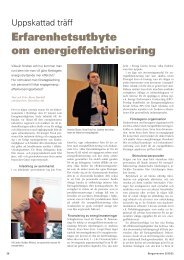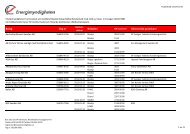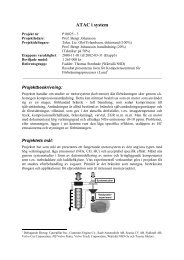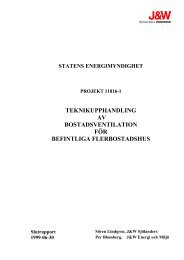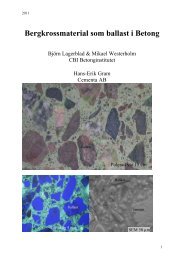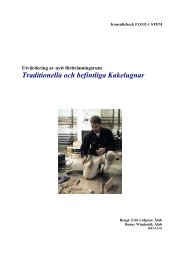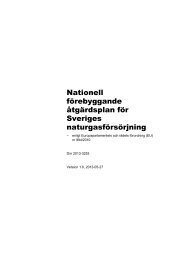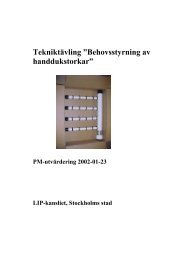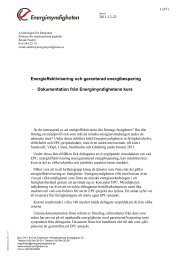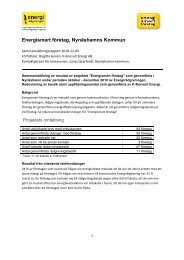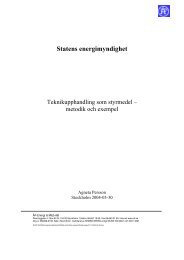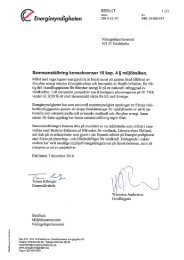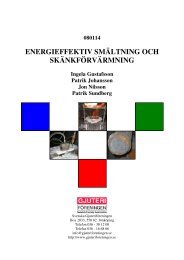Förädling Bränslekvalitet Åkerbränslen - Energimyndigheten
Förädling Bränslekvalitet Åkerbränslen - Energimyndigheten
Förädling Bränslekvalitet Åkerbränslen - Energimyndigheten
You also want an ePaper? Increase the reach of your titles
YUMPU automatically turns print PDFs into web optimized ePapers that Google loves.
genetic maps of each species. Such genetic maps for willow have now been<br />
developed within the project, and are used in the hunt for genetic markers that<br />
influence important growth characteristics. The focus is on the characteristics high<br />
growth-rate, resistance to insect pests and diseases, and tolerance toward frost,<br />
drought and heat. The last of these characteristics is not least in importance for<br />
maintaining and developing Sweden’s leading position in willow breeding now<br />
that the interest for willow increases in southern Europe, and varieties with new<br />
characteristics are in demand. The methods developed are expected not only to<br />
render the selection of plants for onward processing more efficient – which will<br />
reduce commercialization time for new kinds – but also to make the selection of<br />
characteristics that are difficult to evaluate in the field more reliable. Another<br />
important overall project goal is to see if it is possible to predict the production<br />
capacity of a stand of willows in the field based on studies of young, potcultivated<br />
saplings. Within Stage 2 of this synthesis project, an attempt to estimate<br />
the time frame needed for the introduction of these developed methods in practical<br />
use will be made.<br />
The call for proposals regarding harvest technology for willow is expected to<br />
generate alternatives to today’s harvest technology, as the latter has been<br />
identified as a major bottle-neck for increased willow production. Harvest<br />
technologies and methods that not only allow equipment harvest under difficult<br />
weather conditions, but can also cope with thicker trunks and allows harvested<br />
willow to be stored longer, are prerequisites for an increase in the use of willow.<br />
Most of the resources in the Swedish Farmers’ Foundation for Agricultural<br />
Research programme have been put into willow and straw fuels, but matters<br />
concerning reed canary grass and hemp have also received support. The projects<br />
mainly have the character of applied research that can be put into practice<br />
relatively quickly, but there are also projects of a more general nature. Several<br />
good examples of successful technological solutions, knowledge surveys and<br />
preliminary studies that prepare the ground for continued research and<br />
development are worth mention such as knowledge surveys and system studies in<br />
which different aspects of fuel raw material capabilities are analyzed. Annual<br />
crops such as hemp are interesting for growers and will become a necessity if<br />
strong demand is to be met. However, one knowledge gap is which annual crops<br />
would be the most cost efficient. Hemp has not been cultivated in Sweden for<br />
many years, and never previously for energy purposes, so knowledge is lacking in<br />
many areas. The biggest obstacle for hemp today however is its relatively high<br />
cost. In order for hemp to be of interest, costs must be reduced through more<br />
efficient methods and/or simultaneous income from seeds, fibres and oil.<br />
Danish experiences regarding the systems and economics of harvesting,<br />
transporting and storage of straw for energy purposes were collated. Programme<br />
projects focused on reducing loading and transport costs of whole-crop cereals<br />
and other straw-based fuels, the simulation of resources, costs and quality of straw<br />
and how these are affected by weather, geography and the choice of handling<br />
system. The amount of straw available for fuel purposes is estimated at just less<br />
than 1 million tons per year, the equivalent of 3–4 TWh/year, which is almost a<br />
halving of the estimate from the beginning of the programme. A field study<br />
9



